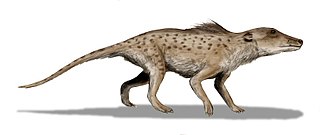
Pakicetidae is an extinct family of Archaeoceti that lived during the Early Eocene in Pakistan. A 2013 publication presents the emergence of cetacea in the Paleogene as starting with the pakicetids.

Carettochelyidae is a family of cryptodiran turtles belonging to the Trionychia. It contains only a single living species, the pig-nosed turtle native to New Guinea and Northern Australia. Stem-group carettochelyids are known from the Cretaceous of Asia, with the family being widely distributed across North America, Europe, Asia and Africa during much of the Cenozoic.

Ambulocetus is a genus of early amphibious cetacean from the Kuldana Formation in Pakistan, roughly 48 or 47 million years ago during the Early Eocene (Lutetian). It contains one species, Ambulocetus natans, known solely from a near-complete skeleton. Ambulocetus is among the best-studied of Eocene cetaceans, and serves as an instrumental find in the study of cetacean evolution and their transition from land to sea, as it was the first cetacean discovered to preserve a suite of adaptations consistent with an amphibious lifestyle. Ambulocetus is classified in the group Archaeoceti—the ancient forerunners of modern cetaceans whose members span the transition from land to sea—and in the family Ambulocetidae, which includes Himalayacetus and Gandakasia.

The snakeheads are members of the freshwater perciform fish family Channidae, native to parts of Africa and Asia. These elongated, predatory fish are distinguished by their long dorsal fins, large mouths, and shiny teeth. They breathe air with gills, which allows them to migrate short distances over land. They have suprabranchial organs, which are primitive forms of labyrinth organs, that develop when they grow older. The two extant genera are Channa in Asia and Parachanna in Africa, consisting of more than 50 species.
Pakotitanops is a genus of poorly known brontothere represented only by a few tooth fragments. Its fossil dates from the middle Eocene Kuldana Formation, in the Ganda Kas area of Pakistan. Because this species is known only from a few tooth fragments it is difficult to compare it to other species to determine if it is indeed a distinct species and to what other species it is mostly closely related.

Pakicetus is an extinct genus of amphibious cetacean of the family Pakicetidae, which was endemic to Pakistan during the Ypresian period, roughly 50 million years ago. It was a wolf-like animal, about 1 metre to 2 metres long, and lived in and around water where it ate fish and other animals. The vast majority of paleontologists regard it as the most basal whale, representing a transitional stage between land mammals and whales. It belongs to the even-toed ungulates with the closest living non-cetacean relative being the hippopotamus.

Anthracobunidae is an extinct family of stem perissodactyls that lived in the early to middle Eocene period. They were originally considered to be a paraphyletic family of primitive proboscideans possibly ancestral to the Moeritheriidae and the desmostylians. The family has also thought to be ancestral to the Sirenia.

Anthracobune is an extinct genus of stem perissodactyl from the middle Eocene of the Upper Kuldana Formation of Kohat, Punjab, Pakistan.
Ishatherium is an extinct genus of ungulate from the early Eocene of the Subathu formation in northwestern India.
Lammidhania is an extinct genus of anthracobunids, which lived from the early to middle Eocene period. Its fossil remains were discovered in 1940 in the Chorlakki locality of the Punjab province of Pakistan.
Nalacetus is an extinct pakicetid early whale, fossils of which have been found in Lutetian red beds in Punjab, Pakistan. Nalacetus lived in a fresh water environment, was amphibious, and carnivorous. It was considered monophyletic by Cooper, Thewissen & Hussain 2009. It was said to be wolf-sized and one of the earliest forms of the order Cetacea.
Gandakasia is an extinct genus of ambulocetid from Pakistan, that lived in the Eocene epoch. It probably caught its prey near rivers or streams.

Ichthyolestes is an extinct genus of archaic cetacean that was endemic to Indo-Pakistan during the Lutetian stage. To date, this monotypic genus is only represented by Ichthyolestes pinfoldi.
Eochanna chorlakkiensis is an extinct prehistoric snakehead. The fish lived in the Lutetian age of the Middle Eocene in the area of what is now the Kuldana Formation near Chorlakki, Pakistan.

Attockicetus is an extinct genus of remingtonocetid early whale known from the Middle Eocene (Lutetian) Kuldana Formation in the Kala Chitta Hills, in the Attock District of Punjab, Pakistan.

The geology of Pakistan encompasses the varied landscapes that make up the land constituting modern-day Pakistan, which are a blend of its geological history, and its climate over the past few million years.

Kala Chitta Range is a mountain range in the Attock District of Punjab, Pakistan. Kala- Chitta are Punjabi words meaning Kala the Black and Chitta means white. The range thrusts eastward across the Potohar plateau towards Rawalpindi.
Agerinia is a genus of adapiform primate that lived in Europe during the early Eocene. Fossils have been found in the Grès d'Assignan, Lignites de Soissonais, and Calcare d'Agel Formations of France, the Corçà and Escanilla Formations of Spain and the Kuldana Formation of Pakistan.
The Kuldana Formation is a fossil-bearing geological formation of Lutetian age which crops out in northern Pakistan. The abundant fossil remains were deposited by rivers and estuaries crossing an arid to semi-arid environment, between several marine transgressions. Its fossil fauna is best known for the early cetaceans Indohyus, Pakicetus and Ambulocetus, that helped to shed a new light on the evolution of whales, but it also features a large number of early ungulates, rodents and primates.
Horaclupea is an extinct genus of freshwater and estuarine ray-finned fish that inhabited the Indian subcontinent from the latest Cretaceous to the early Eocene. It was a clupeid, making it related to modern herrings and anchovies. It was named after Indian ichthyologist Sunder Lal Hora, who described the first species of the genus.










